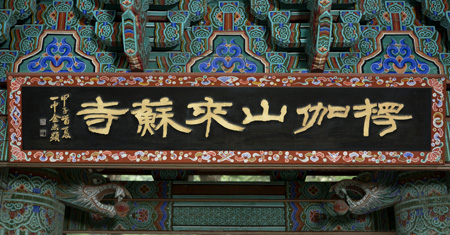Rediscovering Korea through calligraphy
Calligraphy represents not only where we come from but also who we are. It is an essential part of all palace buildings and gates in the long history of Korea and can still be found today.
«Calligraphy Meets Architecture» is an exhibition at the Baegak Art Space in Insa-dong, central Seoul.
In this exhibit, calligraphy and architecture present art and symbols, a partnership that was created many centuries ago. When you visit old temples, you will find famous calligraphy on their front gates that show their names and respective meanings. The South Gate and East Gate in Seoul have their names, Sunginmun and Sungnyemun, which translates to «admiration of love» and «admiration of courtesy,» respectively.
You will also find «hyeonpan,» or signboard, calligraphy hung at the entrance gate of each temple. When you enter the compound of the temple, you will see each building has its name ― for instance, Daewungjeon, the Great Sanctuary for Meditation. Not many people see the calligraphy in front of Seoul National University. Its main entrance has calligraphy of the late Iljoong Kim Choong-hyun (1921-2006) in Korean. If you have not paid attention to the Han River Bridge calligraphy, I encourage you to do so.
Seoul can be a museum as a whole. You will find Kim's Hangul calligraphy on a stone on the Han River Bridge. In 1953, after the Korean War, when the bridge was rebuilt, the builder asked then-president Syngman Rhee to recommend a calligrapher. Rhee chose Kim.
Hangeul has its own calligraphy developed by Kim. Before him, calligraphy used only Chinese characters. Hangeul is based on the sounds of words, while Chinese is based on pictograms. In his adolescent days under Japanese colonial rule (1910-1945), Kim discovered the beauty of Hangeul and developed the art of traditional calligraphy.
Kim eventually established himself as the national calligrapher. You can find his works at the shrine for Admiral Yi Sun-shin on Hansan Island, Hyunchung Temple and many other historical monuments. The calligrapher passed away in 2006. During his lifetime, he left calligraphy on many famous buildings, including the Gyeongbok Palace.
This month, examples of Kim's hyeonpan calligraphy, have been assembled and are on exhibition in Insa-dong as part of a memorial event by the Iljoong Memorial Foundation. Iljoong was his pen name.
 Rediscovering Korea through calligraphy
Rediscovering Korea through calligraphySource: koreatimes.co.kr